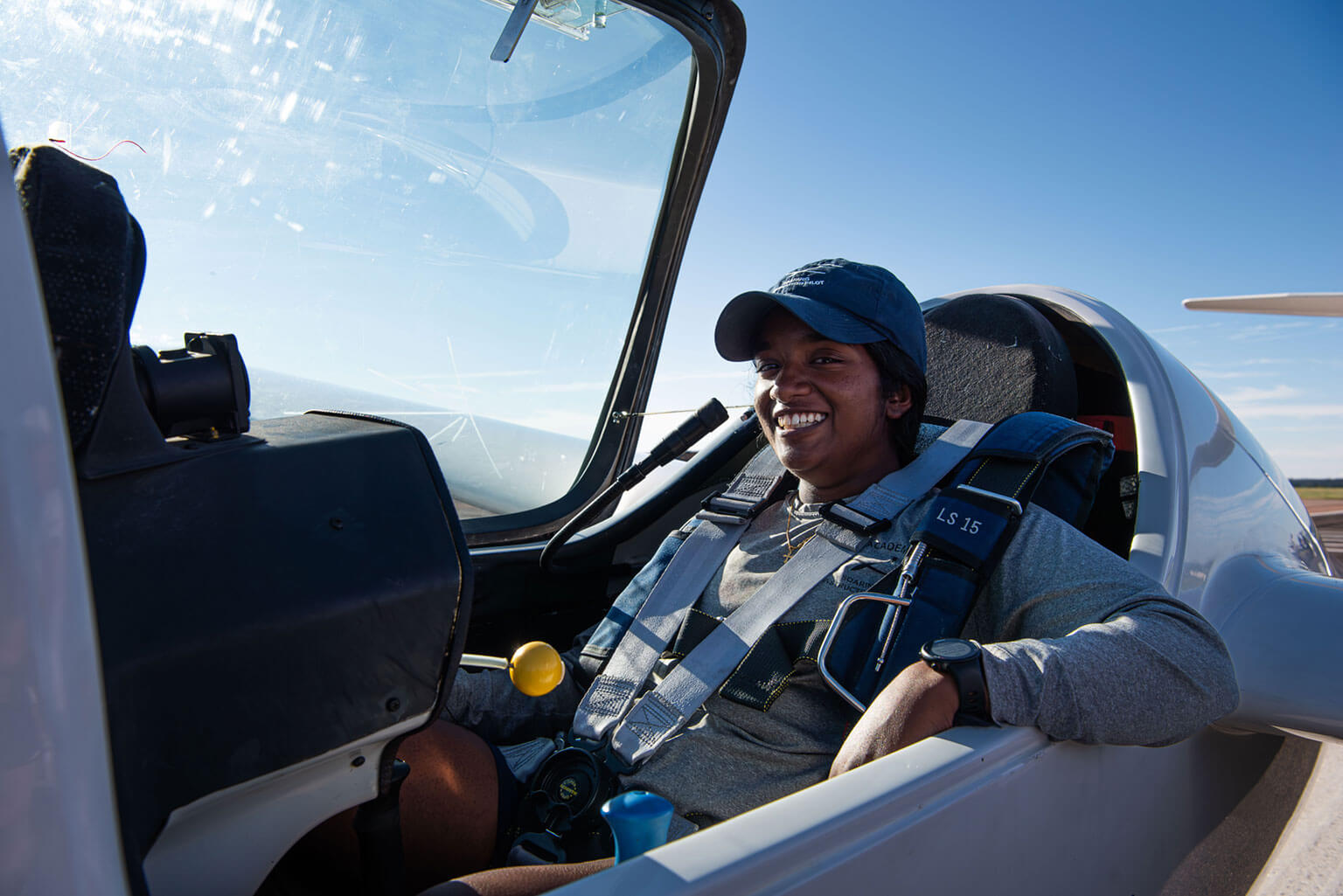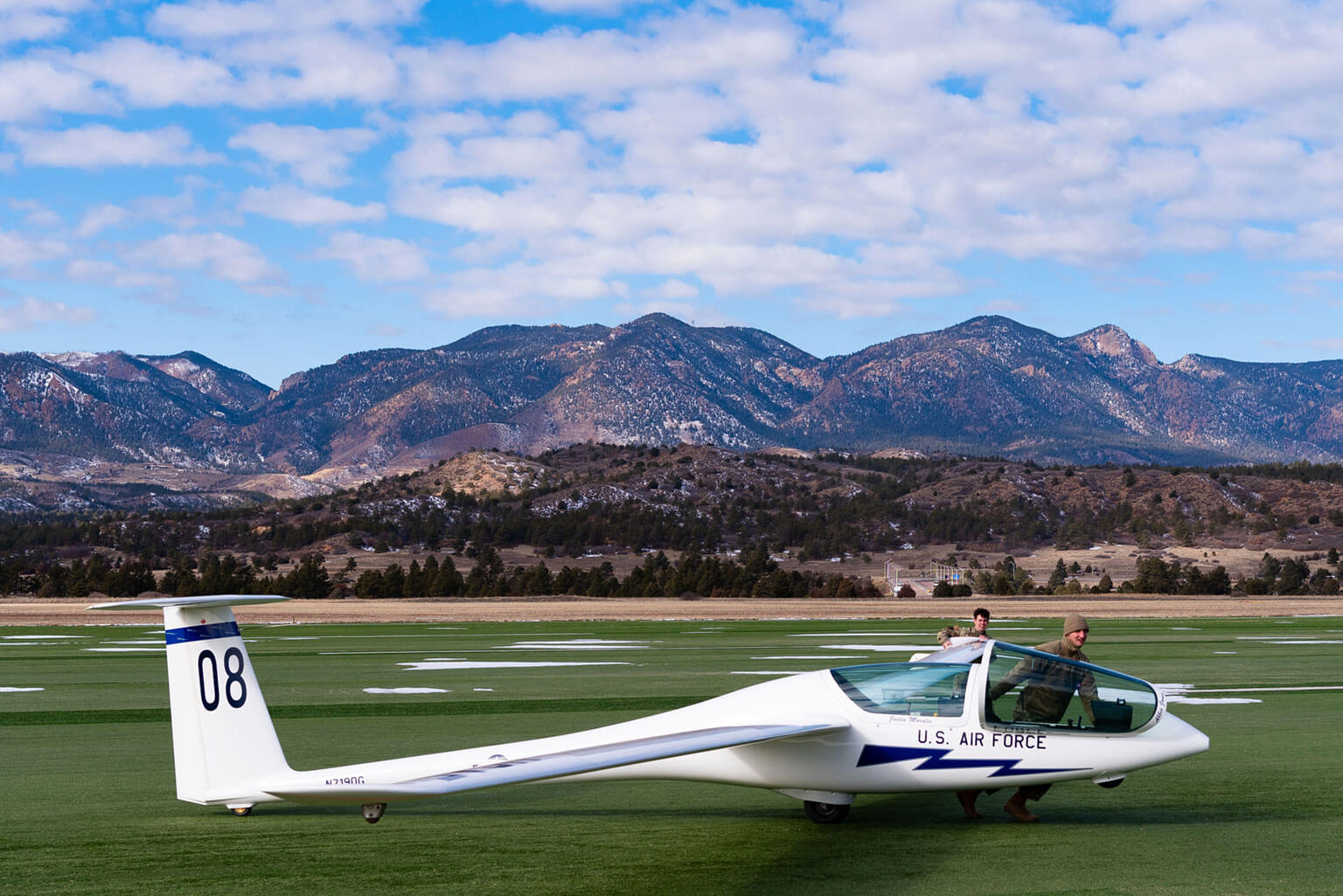Cadets develop airmindedness in soaring program

U.S. Air Force Academy Cadet 1st Class Ruth Anand prepares for her flight in her TG-16A sailplane at Davis Airfield, July 30, 2024. In the Academy’s soaring program, cadets develop critical skills such as communication, leadership, decision-making and situational awareness through hands-on glider experience. (U.S. Air Force photo by Trevor Cokley)
By Randy Roughton
U.S. Air Force Academy Strategic Communications
U.S. AIR FORCE ACADEMY, Colo. – The U.S. Air Force Academy Soaring Program introduces cadets to airmanship principles, airmindedness and the fundamentals of flight. Through hands-on glider experience in the TG-16A sailplane, cadets develop critical skills such as communication, leadership, decision-making and situational awareness.
Soaring is one of three Academy Airmanship Experience Model programs. The programs are designed to develop cadet airmindedness and support the Academy’s goal of developing warfighters ready to lead on day one. Airmindedness is a perspective through which Airmen and Guardians understand the influence of air power for strategic advantage. They know how to control airspace to achieve military goals.
“The soaring program helps cadets develop the confidence to make decisions in the air,” said Cadet 1st Class Ruth Anand, a cadet soaring instructor pilot and mechanical engineering major. “The skills will transfer well into the operational Air Force because you must make competent, credible decisions as a warfighter. It’s all about being humble, credible and approachable. We feed off those characteristics in the program.”

U.S. Air Force Academy Cadets 3rd Class Connor Song, left, and Cadet 2nd Class Alan Davis prepare to take off in their TG-16A sailplane at Davis Airfield, Jan. 29, 2025. In the Academy’s soaring program, cadets develop critical skills such as communication, leadership, decision-making and situational awareness through hands-on glider experience. Developing air-mindedness directly correlates to their future military career. (U.S. Air Force photo by Ray Bahner)
Soaring provides opportunities for solo flights and instruction
The 94th Flying Training Squadron teaches the Basic Soaring Course (Airmanship 472) to cadets. They first learn basic controls and flight maneuvers on simulators and introductory flights. The next stage involves flying with an instructor pilot, followed by the opportunity to fly solo. Cadets who excel in the initial training or show the aptitude to inspire and instruct can be selected as cadet instructor pilots. Those selected complete a year-long program to earn their G-wings that allow them to teach. Cadet instructor pilots conduct 95% of all glider flight instruction.
“The opportunity to fly gliders gives cadets a chance to hone their airmanship skills,” said Capt. Jake Riley, Class of 2017, a 94th Flying Training Squadron member. “In warfare, that means owning the sky. This also allows the cadets to build confidence as technical experts and leaders with the ability to teach others.”

U.S. Air Force Academy Cadets 3rd Class Connor Song, left, and Cadet 2nd Class Alan Davis prepare to take off in their TG-16A sailplane at Davis Airfield, Jan. 29, 2025. In the Academy’s soaring program, cadets develop critical skills such communication, leadership, decision-making and situational awareness through hands-on glider experience. (U.S. Air Force photo by Ray Bahner)
Cadets develop leadership skills through instruction
Anand began the soaring program because of her love for flying. She was selected for the instructional pilot upgrade program and soon discovered she equally enjoys the program’s instructional aspect. Cadet instructors gain practical experience in leading other cadets. They serve as role models for younger cadets and reinforce the concepts of flight, navigation and operations to the real-life application of these principles via soaring.
“I am passionate about flying, but I never realized how much I would love teaching my fellow cadets,” Anand said. “You get to take a 19-year-old who has never even been in an airplane before. When you see them reach the point where they fly on their own, it is so fulfilling.”
Sabre 1 exhibit planned at the Hosmer Visitor Center
Due to the success of the glider program in developing air-minded leaders, a glider will be a prominent feature in the new visitor center.
When the Lt Gen Bradley and Zita Hosmer Visitor Center opens at the Academy’s north gate, it will include an exhibit that honors the TG-10C glider also known as Sabre 1. The TG-10C was the 94th Flying Training Squadron’s sailplane of choice for basic and aerobatic training until 2012.
Sabre 1’s tail was signed by Patty Wagstaff, a U.S. national aerobatic champion. Sabre 1 will be suspended as if recovering from a loop in the new Hosmer Visitor Center atrium. The glider will be illuminated at night to be visible from the outside of the center.
See photos of Academy airmanship programs.